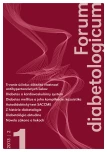Diabetes and atrial fibrillation
Authors:
Ján Murín 1; Marta Filková Karabová 1; Miroslav Pernický 1; Martin Wawruch 2
Authors‘ workplace:
I. interná klinika LF UK a Nemocnica Staré Mesto, UNB, Bratislava, prednostka doc. MUDr. Soňa Kiňová, PhD.
1; Ústav farmakológie a klinickej farmakológie LF UK, Bratislava, prednostka prof. MUDr. Viera Kristová, CSc.
2
Published in:
Forum Diab 2013; 2(1): 27-30
Category:
Overview
Atrial fibrillation is the most common sustained arrhythmia in routine clinical practice and is associated mainly with heart failure and thromboembolic events, particularly stroke. Its incidence increases with age and with improvements in treatment of other cardiovascular diseases. Similar epidemiological facts refer to diabetes as well. The incidence increases with the incidence of obesity and patients with diabetes mainly suffer from cardiovascular diseases, which increase their morbidity and mortality. Epidemiological data have shown that diabetes is also a risk factor for atrial fibrillation. The authors analyze etiopathogenetic relations of the both diseases, their clinical consequences and approaches to treatment as well.
Key words:
diabetes – atrial fibrillation – cardiovascular disease
Sources
1. Williams B, Poulter BR, Brown MJ et al. Guidelines for management of hypertension: report of the fourth working party of the British Hypertension Society. J Hum Hypertens 2004; 18(3): 139–185.
2. Tayebjee MH, Lim HS, MacFadyen RJ et al. Matrix metalloproteinase-9 and tissue inhibitor of metalloproteinase-1 and -2 in type 2 diabetes: effect of 1 year’s cardiovascular risk reduction therapy. Diabetes Care 2004; 27(8): 2049–2051.
3. Lim HS, MacFadyen DC, Lip GZ et al. Diabetes mellitus, the renin/angiotensin/aldosterone system, and the heart. Arch Intern Med 2004; 164(16): 1737–1748.
4. Lip GY, Felmeden DC, Li-Saw-Hee FL et al. Hypertensive heart disease. A complex syndrome or a hypertensive cardiomyopathy? Eur Heart J 2000; 21(20): 1653–1665.
5. Kannel WB, Abbott RD, Savage DD et al. Epidemiologic features of chronic atrial fibrillation: the Framingham study. N Engl. J Med 1982; 306(17): 1018–1022.
6. Friberg J, Buch P, Scharling H et al. Rising rates of hospital admissions for atrial fibrillation. Epidemiology 2003; 14(6): 666–672.
7. Benjamin EJ, Levy D, Vaziri SM et al. Independent risk factors for atrial fibrillation in a population-based cohort. The Framingham heart study. JAMA 1994; 271(11): 840–844.
8. Barriales Alvarez V, Moris de la Tassa C, Sanchez Posada I et al. The etiology and associated risk factors in a sample of 300 patients with atrial fibrillation. Rev Esp Cardiol 1999; 52(6): 403–414.
9. Psaty BM, Manolio TA, Kuller LH et al. Incidence of and risk factors for atrial fibrillation in older adults. Circulation 1997; 96(7): 2455–2461.
10. Wilhelmsen L, Rosengren A, Lappas G. Hospitalizations for atrial fibrillation in the general male population: morbidity and risk factors. J Intern Med 2001; 250(5): 382–389.
11. Kalus JS, White CM, Caron MF et al. Indicators of atrial fibrillation risk in cardiac surgery patients on prophylactic. Amiodarone. Ann Thorac Surg 2004; 77(4): 1288–1292.
12. Ostgren CJ, Merlo J, Rastam L et al. Atrial fibrillation and its association with type 2 diabetes and hypertension in a Swedish community. Diabetes Obes Metab 2004; 6(5): 367–374.
13. Movahed M-R, Hashemzadeh M, Jamal MM. Diabetes mellitus is a strong, independent risk for atrial fibrillation and flutter in addition to other cardiovascular disease. Intern J Cardiol 2005; 105(3): 315–318.
14. Odeh M, Oliven A, Bassan H. Transient atrial fibrillation precipitated by hypoglycemia. Ann Emerg Med 1990; 19(5): 565–567.
15. Collier A, Matthews DM, Young RJ et al. Transient atrial fibrillation precipitated by hypoglycaemia: two case reports. Postgrad Med J 1987; 63(44): 895–897.
16. Rigalleau V, Baillet L, Hocini M et al. Atrial fibrillation can cause major hyperglycemia. Diabetes Metab 2002; 28(3): 239–240.
17. Guzman E, Singh N, Khan IA et al. Left bundle branch block in type 2 diabetes mellitus: a sign of advanced Cardiovascular involvement. Ann Noninvasive Electrocardiol 2004; 9(4): 362–365.
18. MacFayden RJ, Lim HS. Emergence of structural arterial stiffness in diabetes and the role of abnormalities of autonomic tone in the sequence of events. J Hum Hypertens 2004; 18(11): 755–756.
19. Hamaad A, Lip GY, Mac Fadyen RJ. Heart rate variability estimates of autonomic tone: relationship to mapping pathological an procedural stress responses in coronary disease. Ann Med 2004; 36(6): 448–461.
20. Veglio M, Chinaglia A, Cavallo-Perin P. QT interval, cardiovascular risk factors and risk of death in diabetes. J Endocrinol Investig 2004; 27(2): 175–181.
21. Rana BS, Band MM, Ogston S et al. Relation of QT interval dispersion to the number of different cardiac abnormalities in diabetes mellitus. Am J Cardiol 2002; 90(5): 483–487.
22. Gustafsson I, Brendorp B, Seibaek M et al. Influence of diabetes and diabetes-gender interaction on the risk of death in patients hospitalized with congestive heart failure. J Am Coll Cardiol 2004; 43(5): 771–777.
23. Whang W, Bigger Jr JT. Comparison of the prognostic value of RR interval variability after acute myocardial infarction in patients with versus those without diabetes mellitus. Am J Cardiol 2003; 92(3): 247–251.
24. Franklin K, Goldberg RJ, Spencer F et al. Implications of diabetes in patients with acute coronary syndromes. The global registry of acute coronary events. Arch Intern Med 2004; 164(13): 1457–1463.
25. Jonas M, Reicher-Reiss H, Boyko V et al. Hospital and 1-year outcome after acute myocardial infarction in patients with diabetes mellitus and hypertension. J Hum Hypertens 2003; 17(10): 665–670.
Labels
Diabetology Endocrinology Internal medicineArticle was published in
Forum Diabetologicum

2013 Issue 1
Most read in this issue
- Diabetes mellitus and its complications: case report
- Duration of Action as an Important Characteristic of Antihypertensive Drugs
- Heart failure and diabetes
- Cardiorenal syndrome in the context of diabetes mellitus
